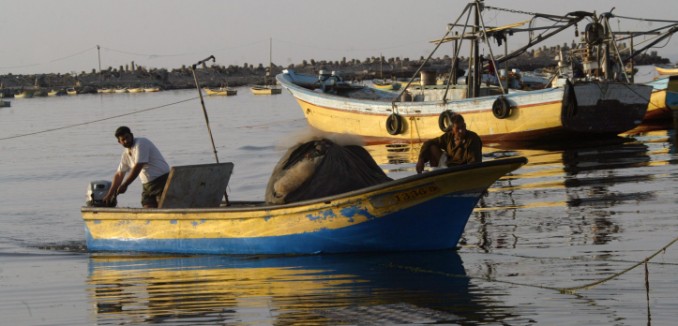The Israeli Navy arrested a Hamas-affiliated smuggler who took advantage of recently relaxed limits on fishing boats from the Gaza Strip to bring in weapons and materials that could be used to build rockets, Israel’s internal security service announced on Monday.
Salim Jamal Hassan Naman, who was arrested last month, told interrogators that he had been involved in a smuggling operation that transported weapons and materials into Gaza such as fiberglass resin, which can be used to manufacture of rockets, the Shin Bet said.
Israel’s Defense Ministry extended the permissible range that Gazan fishing boats can travel from six to nine nautical miles last month. The Shin Bet accused Hamas of “taking advantage” of the relaxed regulations to smuggle in weapons.
Naman was detained after his boat “deviated from the approved sailing area,” according to the Shin Bet. Despite his ties to Hamas, Naman admitted that he also smuggled weapons on behalf of other terrorist groups operating in Gaza.
Israel interdicted a shipment of ammonium chloride that could be used in the production of rockets two weeks ago. The chemical was hidden in a shipment of salt.
In recent weeks the Israeli military uncovered two terror tunnels built by Hamas that extended into Israel territory. The Shin Bet arrested two Hamas operatives in April who gave authorities significant intelligence about the tunnels.
Gen. Yossi Kuperwasser, formerly the head of the research division of Israeli military intelligence and later the director general of the Ministry of Strategic Affairs, told reporters earlier this month that the discovery of the tunnels was a sign that Hamas was preparing for another war against Israel. He added that the tunnel digging means that “they definitely invest a lot in making the necessary preparations so that in the next round, when they decide to start it, they will be able to inflict the heaviest damage on Israel, including through those tunnels.”
In Your Complete Guide to Hamas’ Network of Terror Tunnels, which was published in the April 2016 issue of The Tower Magazine, Dan Feferman observed that the people of Gaza pay the price for Hamas’ efforts to rebuild its terror tunnels and prepare for war against Israel.
There is a tragic side to Hamas’ tunnel strategy. Roughly 9,000 homes were destroyed during Protective Edge, and very few have been rebuilt. This is not Israel’s fault, as building supplies flow regularly into Gaza. But according to declassified intelligence reports, these supplies are routinely stolen by Hamas in order to serve the group’s terrorist purposes. Hamas smuggles in cement, diverts from construction and humanitarian donations, and even raids civilian construction sites in order to rebuild its tunnels. Estimates are that one tunnel can cost a million dollars to build and uses around 50,000 tons of concrete. Close to a million tons of concrete were poured into the terror tunnels before 2014.
The tunnels, in this sense, are a zero-sum game. If the same materials were put into reconstruction, the Gazan people would be better off and, lacking this crucial asymmetric warfare capability, Hamas would be less tempted to attack Israel. On the other hand, with the same limited materials going to terror tunnels, the people of Gaza continue to live in ruins while Hamas rebuilds its war machine.
While Hamas appears to be deterred in the short term, it continues to believe that the tunnels are its only strategic weapon. While it may not be interested in another war, the tunnels continue to be dug for a reason. Once used, however, they lose their effectiveness, as the IDF knows their locations and can thus destroy them. Hamas is well aware of this dilemma. The tunnels essentially leave Israel and Hamas in an arms race—with Israel racing to develop a technological solution before Hamas decides to launch another round of fighting.
[Photo: Abed Rahim Khatib / Flash90 ]




